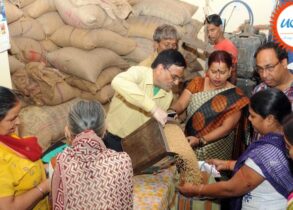Is inclusive growth possible under market economy? State the significance of financial inclusion in achieving economic growth in India.
Introduction:
As per OECD inclusive growth is economic growth that is distributed fairly across society and creates opportunities for all. It lessens the fast growth rate of poverty in a country and upsurges the participation of people in the development of the country.
Body:
The majority of economic decisions in a market economy are made through voluntary transactions that follow the rules of supply and demand. The command economy, in which economic planning and choices are centralised, is the opposite. LPG reforms implemented in India in 1991 are regarded as a step toward a market economy.
Is it possible to achieve inclusive growth in a market economy? It is conceivable, yes:
- Rising government spending: India’s budget today is approximately 34 lakh, compared to 1.13 lakh in 1991–1992.
- Decreased poverty: Since the 1980s, market reforms in China have helped about 80 crore people escape poverty.
- According to the trickle-down effect theory, the advantages of greater expansion eventually trickle down to all facets of society.
- Female employment: Women-centric economic development initiatives have helped Bangladesh move up to the 34th spot on the list of emerging economies in the World Economic Forum’s Inclusive Development Index, far ahead of South Asian rivals India (62), Pakistan, and Sri Lanka. • Competition and Skill Growth: Since 1991, there has been a noticeable change in the structure of India’s export basket, with the share of engineering goods and chemical products rising significantly while the share of leather, textiles, and ready-made clothes has declined considerably.
However, there are obstacles to inclusive growth in the market economy:
- Regional disparities: Market economies frequently concentrate on industries and regions that are performing well, which pushes backward regions further and further behind. For instance, Karnataka and Maharashtra received 64% of total FDI equity inflows in 2021–2022 alone.
- Environmental concerns: In an effort to entice investment, nations open their markets, but owing to global competition, they are tempted to ease labour, environmental, and tax rules at the expense of social policies, leading to a race to the bottom.
- Income inequality: From 8.5% in 1991 to 2.8% in 2020, the lowest 50%’s share of the nation’s wealth has decreased steadily. A distorted and GDP-focused approach hinders inclusive growth even though the market economy promotes it. As a result, countries should prioritise both GDP growth and human development.
Significance of financial inclusion in achieving economic growth in India: Financial inclusion is the process of facilitating access to the formal financial system and thereby various financial products and services at affordable prices. Such as Bank accounts, affordable credit, insurance etc, Significance:
- Gaining growth and equity: Financial inclusion contributes to economic development by fostering a culture of saving among a significant portion of the rural population and expanding the financial system’s resource base.
- Channels the poor’s savings into regulated financial institutions and mobilises them for investments. More than 43.04 billion beneficiaries have deposited money through PMJDY since it began, totaling Rs. 146,231 billion.
- Decline in Cash Economy: As more money enters the banking system, the economy’s reliance on cash declines. Due to this, the UPI ecosystem has been successful. In FY22, UPI executed more than 46 billion transactions totaling more than Rs 84.17 trillion.
- Decreases corruption: The Direct Benefit Transfer (DBT) method is expected to save the government around 44,000 crores in the fiscal 2020–21 period.
- Entrepreneurial spirit: The general public’s capacity to access sufficient and transparent credit through official banking channels would encourage their own entrepreneurial spirit, which will boost rural productivity and prosperity.
Conclusion: Financial inclusion is also a major step toward inclusive growth which ensures the overall economic development of the marginalised sections of the society 4
Q3. What are the major challenges of the Public Distribution System (PDS) in India? How can it be made effective and transparent?
Introduction:
The Public Distribution System (PDS) is an Indian food security system which evolved as a system for the distribution of food grains at affordable prices and management of emergency situations.
Body:
Under the National Food Security Act (NFSA), 2013, PDS is being implemented across all States and UTs. According to the Act, food grains (rice, wheat, and coarse grains) can be distributed at prices of Rs. 3/2/1 per kg to up to 75% of the rural population and 50% of the urban population, respectively.
Challenges:
- Identification of beneficiaries:
- In the beneficiary statistics, there are significant inaccuracies in the removal and inclusion of households that are Below Poverty Line (BPL) and Above Poverty Line (APL). Lack of reliable regular data and consistent government estimates of household actual income exacerbate the targeting issue.
- While people who are ineligible are receiving improper benefits, rightful beneficiaries are not receiving food grains. A Ministry of Rural Development expert panel that examined the BPL census methodology discovered that 25% of non-poor households and approximately 61% of the eligible people were both left off the BPL list.
- The appearance of ghost cards in various states is another sign of incorrect beneficiary classification. Cards created in the names of nonexistent people are known as “ghost cards.” Ghost cards suggest that grains are being stolen from deserving homes and sold on the open market.
- Shortfall in storage capacity with FCI against the central pool stock:
- The CAG’s performance audit has identified a significant storage capacity gap in the government.
- The food grains that have been purchased must be kept as a buffer stock once responsibilities under TPDS have been fulfilled. Although there has been a significant increase in purchasing, FCI’s storage capacity (both owned and hired) has not risen in step with the growth in purchasing.
- Rising Subsidy and financial burden:
- There are further concerns regarding patterns in procurement in comparison to food grain production. According to recent figures, the central government purchases around a third of the locally produced cereals. The NFS Act is projected to increase the quantity earmarked for procurement, which raises questions about how long such a food distribution system can last.
- Concerns have also been raised about the system’s viability from a financial standpoint. Because the cost of obtaining and shipping food grains is almost six times their retail price, the centre is forced to shoulder a significant financial burden. The Act’s increased grain procurement, associated expenses, and other variables are expected to cause the food subsidy to expand steadily.
- Inconsistent quality:
- The vast majority of responders claimed that the ration quality varies—sometimes it’s great, sometimes it’s terrible. The criticisms mostly related to the poor quality of the wheat. The majority of recipients weren’t happy with the wheat and rice’s quality.
- Corruption and leakages:
- High levels of corruption and leakage still plague the PDS despite the important, system-wide adjustments made in recent years. A portion of this leakage happens at the level of the fair price shops, where some shop owners swap out the high-quality government-provided goods for general store products of lower quality.
- Some believe the dual pricing made possible by the TPDS will encourage stakeholders to shift goods to the open market where they can fetch a greater price.
- Lack of transparency in the selection procedure of PDS dealers.
Ways to make it effective and transparent:
- End to End computerisation:
- The Justice Wadhwa Committee Report for PDS (2011) recommended computerization for two reasons: first, to prevent diversion; and second, to allow for safe identification at ration stores.






